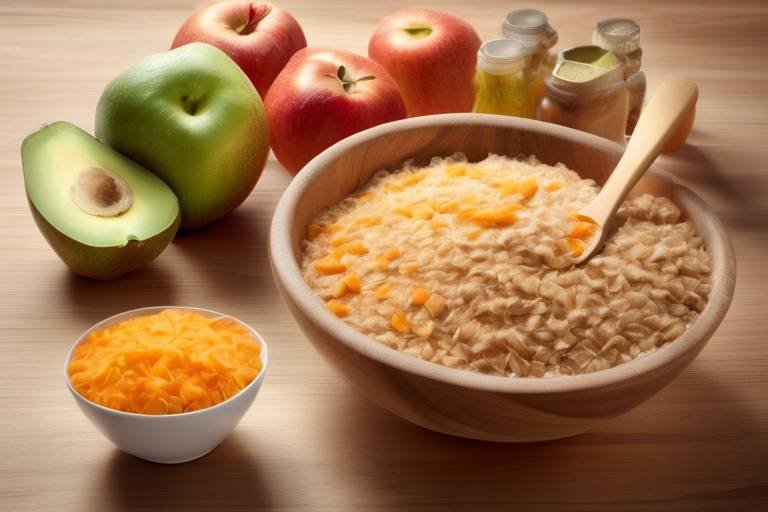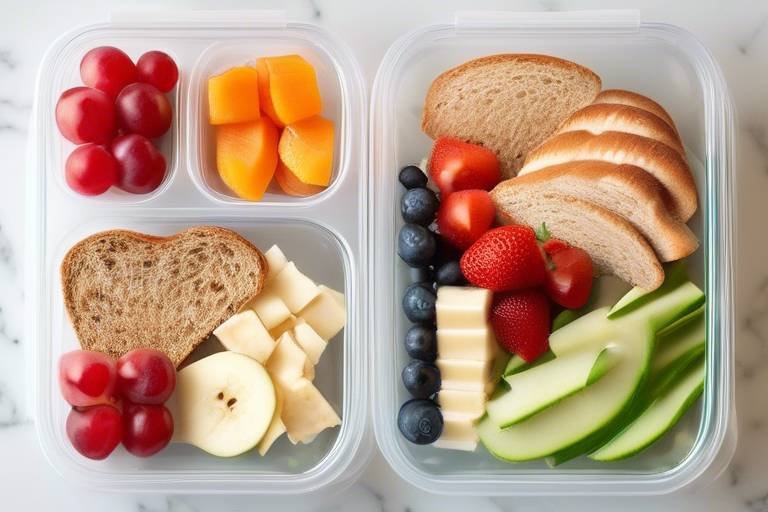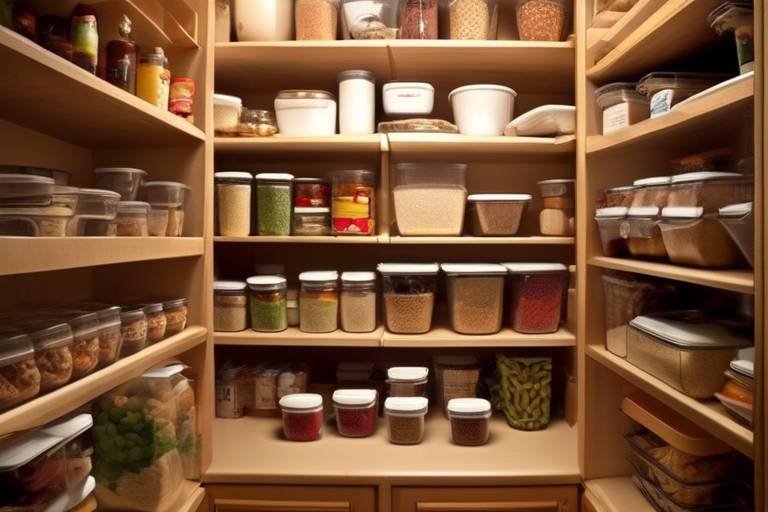How to Add More Fiber into Your Family's Diet
In today’s fast-paced world, it’s easy for families to overlook the importance of fiber in their diets. Many of us are so busy juggling work, school, and activities that we forget about the simple yet powerful role that fiber plays in our health. But what if I told you that adding more fiber to your family’s meals can be both easy and delicious? Not only does fiber help with digestion, but it also keeps our hearts healthy and our waistlines in check. Let’s dive into some effective strategies to boost your family’s fiber intake without sacrificing taste!
Dietary fiber is a type of carbohydrate that the body can’t digest. Unlike other carbs, fiber passes through the digestive system relatively intact, which is why it’s so crucial for maintaining digestive health. There are two main types of fiber: soluble and insoluble. Soluble fiber dissolves in water and can help lower cholesterol and regulate blood sugar levels. On the other hand, insoluble fiber adds bulk to the stool and helps food pass through the digestive tract more easily. Understanding these differences can help families appreciate why they need to incorporate a variety of fiber-rich foods into their diets.
Embracing a high-fiber diet can lead to a plethora of health benefits for your family. From improved digestion to better weight management, fiber is a superhero nutrient that deserves a spotlight. Did you know that a fiber-rich diet can also reduce the risk of chronic diseases such as diabetes and heart disease? It’s true! When families prioritize fiber, they not only enhance their well-being but also create a foundation for a healthier lifestyle. So, let’s break down some specific advantages that come with increasing fiber intake.
One of the most significant roles of fiber is its impact on digestive health. Think of fiber as a broom that sweeps through your intestines, keeping everything clean and functioning smoothly. Regular consumption of fiber can prevent constipation, which is a common issue for both children and adults. By incorporating fiber-rich foods into your family meals, you can promote regular bowel movements and ensure that everyone feels their best.
Constipation can be a real pain—literally! It’s essential to include effective fiber sources in your family's diet to combat this issue. Foods like beans, lentils, whole grains, fruits, and vegetables are fantastic options. For instance, a simple switch from white bread to whole grain can significantly increase fiber intake. By making these small changes, you can help your family stay regular and comfortable.
Did you know that fiber also plays a crucial role in nurturing the good bacteria in our gut? A healthy gut microbiome is essential for overall health, and fiber-rich foods like fruits, vegetables, and whole grains can help foster this balance. When you feed your family fiber, you’re also feeding the beneficial bacteria that keep everyone’s digestive system in tip-top shape. It’s like giving your gut a warm hug!
Incorporating more fiber into meals can be a game-changer for families trying to manage their weight. Fiber-rich foods are often low in calories but high in volume, which means they can help you feel fuller for longer. This can lead to fewer cravings and less snacking throughout the day. Imagine sitting down to a hearty bowl of oatmeal topped with berries—delicious, filling, and packed with fiber! By making fiber a priority, families can find it easier to maintain a healthy weight without feeling deprived.
Now that we understand the importance of fiber, how can we make it a regular part of our meals? The good news is that there are plenty of practical tips and simple changes families can implement to boost their fiber intake without overwhelming effort. Here are a few ideas to get you started:
Switching to whole grains is a straightforward yet effective way to increase fiber. Instead of reaching for white rice or pasta, opt for brown rice, quinoa, or whole grain pasta. These swaps not only add fiber but also enhance the flavor and texture of your meals. Next time you’re at the grocery store, take a moment to explore the whole grain aisle—it might surprise you!
Fruits and vegetables are excellent sources of fiber, and they can be easily incorporated into family meals and snacks. Try adding spinach to your smoothies, or toss some berries into your morning oatmeal. Not only do these additions boost fiber intake, but they also provide essential vitamins and minerals. Make it a fun family challenge to try a new fruit or veggie each week—who knows, you might discover a new favorite!
- What are some high-fiber foods I can easily add to my family's diet? Foods like beans, lentils, whole grains, fruits, and vegetables are excellent choices.
- How much fiber should my family consume daily? Aim for about 25 grams for women and 38 grams for men, but adjust based on individual needs.
- Can increasing fiber too quickly cause digestive issues? Yes, it’s best to increase fiber gradually and drink plenty of water to help your body adjust.

Understanding Dietary Fiber
Dietary fiber is an essential component of a healthy diet, yet many families find it challenging to consume adequate amounts. It's not just about filling your plate with greens; understanding the different types of fiber and their benefits can help families appreciate how vital these foods are for overall health. Fiber comes in two primary forms: soluble and insoluble. Soluble fiber dissolves in water, forming a gel-like substance in the digestive tract. This type of fiber can help lower blood cholesterol and glucose levels. On the other hand, insoluble fiber does not dissolve in water and adds bulk to the stool, aiding in digestion and preventing constipation.
Both types of fiber are crucial for maintaining a balanced diet. Soluble fiber is found in foods like oats, beans, and fruits, while insoluble fiber is abundant in whole grains, nuts, and vegetables. By incorporating a variety of these fiber-rich foods into your family's meals, you can ensure that everyone benefits from the health advantages fiber has to offer. It’s like having a superhero in your pantry, working behind the scenes to keep your digestive system running smoothly!
Moreover, fiber is not just about digestion; it also plays a significant role in long-term health. Research shows that a high-fiber diet can reduce the risk of various chronic diseases, including heart disease, diabetes, and certain types of cancer. This makes it even more important for families to understand and prioritize fiber in their daily meals. Imagine fiber as a shield that protects your family from health issues while promoting a feeling of fullness, which can help in maintaining a healthy weight.
Incorporating fiber into your diet doesn't have to be a daunting task. In fact, it can be fun! Think of it as a culinary adventure where you explore new foods and flavors. For instance, swapping out white rice for brown rice or adding a handful of berries to your morning oatmeal can be simple yet effective ways to boost fiber intake. Remember, every little change counts, and the benefits will be felt by everyone!
To sum up, understanding dietary fiber is the first step toward a healthier lifestyle for your family. By embracing both soluble and insoluble fibers, you can enhance your meals and improve your overall well-being. So, why not start today? Your body will thank you!

Benefits of a High-Fiber Diet
When it comes to our health, fiber is often the unsung hero that doesn't get the spotlight it deserves. A high-fiber diet is not just a trendy buzzword; it's a vital component of a healthy lifestyle that can transform how your family feels and functions daily. Imagine your digestive system as a bustling highway—fiber acts like the traffic lights and signs that keep everything moving smoothly. Without enough fiber, traffic can get jammed, leading to discomfort and other health issues. So, what are the specific benefits of incorporating more fiber into your family's meals? Let's dive into the details!
First off, one of the most significant advantages of a high-fiber diet is improved digestion. Fiber comes in two forms: soluble and insoluble. Soluble fiber dissolves in water and helps to slow digestion, which can be beneficial for regulating blood sugar levels. On the other hand, insoluble fiber adds bulk to your stool and helps it pass through your digestive tract more easily. This combination is essential for keeping your family's digestive system running like a well-oiled machine. Regular consumption of fiber-rich foods can help prevent constipation and promote regular bowel movements, ensuring that everyone feels comfortable and healthy.
Speaking of digestion, let's take a closer look at how fiber plays a key role in maintaining a healthy gut. A fiber-rich diet can help prevent constipation, which is a common issue for both children and adults. When fiber is consumed, it absorbs water and swells, helping to form a soft, bulky stool that is easier to pass. This is particularly important for families, as children often struggle with digestive issues. By introducing foods like whole grains, fruits, and vegetables into your meals, you can significantly reduce the chances of digestive discomfort.
To illustrate, consider the following fiber-rich foods that can be easily incorporated into daily meals:
- Oats: A great breakfast option that can kickstart your day with a fiber boost.
- Beans: Perfect for soups, salads, or as a side dish, beans are packed with fiber.
- Fruits: Apples, pears, and berries are not only delicious but also high in fiber.
- Vegetables: Carrots, broccoli, and Brussels sprouts are excellent choices for side dishes.
In addition to preventing constipation, fiber also promotes a healthy gut flora. A diverse and balanced gut microbiome is essential for overall health, and fiber-rich foods serve as food for the beneficial bacteria in your gut. These good bacteria help break down food, produce essential nutrients, and even boost your immune system. By incorporating more fiber into your family's diet, you're not just aiding digestion; you're also fostering a thriving community of gut bacteria that can enhance your family's overall well-being.
Another remarkable benefit of a high-fiber diet is its role in weight management. If you've ever felt like you could eat a mountain of salad but still be hungry afterward, you're onto something! Fiber-rich foods tend to be more filling, which can help curb hunger and reduce overall calorie intake. When your family feels full longer, they are less likely to reach for unhealthy snacks between meals. This makes it easier to maintain a healthy weight without feeling deprived.
In summary, the benefits of a high-fiber diet are vast and impactful. From improved digestion to better weight management and a healthier gut, fiber is a crucial element that can enhance your family's health in numerous ways. So, why not start incorporating more fiber-rich foods into your meals today? Your family will thank you for it!
Q: How much fiber should my family consume daily?
A: The recommended daily intake of fiber varies by age and gender, but generally, adults should aim for about 25-30 grams per day, while children need about 14-31 grams depending on their age.
Q: Can I get enough fiber from supplements?
A: While fiber supplements can help, it's best to obtain fiber from whole foods like fruits, vegetables, and grains for maximum health benefits.
Q: What are some easy ways to add fiber to meals?
A: Start by swapping white bread for whole-grain options, adding beans to soups, and incorporating more fruits and vegetables into snacks and meals.

Digestive Health
When it comes to maintaining a healthy digestive system, fiber is your best friend. It’s like the unsung hero of our diets, quietly working behind the scenes to keep everything running smoothly. Imagine your digestive tract as a bustling highway; fiber acts like the traffic signals that help everything flow without a hitch. Without enough fiber, this highway can become congested, leading to issues like constipation and discomfort.
Fiber is generally categorized into two types: soluble and insoluble. Soluble fiber dissolves in water and forms a gel-like substance, which can help lower cholesterol and stabilize blood sugar levels. You can find soluble fiber in foods like oats, beans, and apples. On the other hand, insoluble fiber doesn’t dissolve in water; instead, it adds bulk to your stool and helps food pass more quickly through the stomach and intestines. Think of it as the broom that sweeps through your digestive tract, making sure everything is clean and clear. Sources of insoluble fiber include whole grains, nuts, and vegetables like carrots and celery.
So, how does fiber prevent constipation? It’s simple! When you consume enough fiber, it absorbs water and swells in your stomach, creating a feeling of fullness and promoting regular bowel movements. This is especially important for children, as they often have less fiber in their diets than adults. By encouraging your family to eat more fiber-rich foods, you’re not just helping them avoid the discomfort of constipation; you’re also teaching them healthy eating habits that will last a lifetime.
To make it easier for families to incorporate fiber into their diets, consider these delicious options:
- Start your day with a hearty bowl of oatmeal topped with fruits and nuts.
- Swap out white bread for whole grain or sprouted bread for sandwiches.
- Add beans to salads and soups for a fiber boost.
- Snack on raw veggies with hummus or a fruit salad instead of chips.
In addition to preventing constipation, fiber also promotes a healthy gut flora, which is essential for overall digestive health. A balanced gut microbiome is like a flourishing garden, where beneficial bacteria coexist and help break down food, absorb nutrients, and even support your immune system. By consuming a variety of fiber-rich foods, you’re essentially feeding these good bacteria, allowing them to thrive and keep your digestive system in tip-top shape.
In summary, integrating more fiber into your family’s diet is a simple yet effective way to enhance digestive health. Not only does it help prevent constipation, but it also fosters a healthy gut environment, paving the way for better overall well-being. So, the next time you sit down for a family meal, remember that adding fiber can transform your dining experience into a nourishing and health-promoting occasion.
What are some easy ways to increase fiber intake in my family’s diet?
Start by incorporating whole grains, adding more fruits and vegetables to meals, and including legumes like beans and lentils. Small changes, like swapping white rice for brown rice, can make a big difference!
How much fiber should my family consume daily?
The recommended daily fiber intake is about 25 grams for women and 38 grams for men. For children, it varies based on age, but a good rule of thumb is to add 5 to their age to find the appropriate amount in grams.
Can too much fiber be harmful?
While fiber is beneficial, consuming it in excess can lead to bloating and gas. It’s best to increase fiber intake gradually and drink plenty of water to help it move through your system.

Preventing Constipation
Constipation can be a real pain—literally! It’s something that many families face, yet it’s often brushed aside as a minor inconvenience. The truth is, regular bowel movements are essential for everyone, from toddlers to grandparents. So, how can we make sure our loved ones stay regular and comfortable? The answer lies in fiber. Increasing fiber intake is one of the most effective ways to prevent constipation, and it can be done without overhauling your entire diet.
When we talk about fiber, we’re referring to the parts of plant foods that our bodies can’t digest. There are two main types: soluble fiber, which dissolves in water and helps to soften stool, and insoluble fiber, which adds bulk to the stool and helps food pass more quickly through the digestive tract. Both types are crucial for maintaining a healthy digestive system. Aim to include a mix of both in your family’s meals!
So, what are some easy ways to add fiber to your family's diet? Here are a few effective strategies:
- Start the Day Right: Breakfast is a golden opportunity to load up on fiber. Consider switching to whole grain cereals or oatmeal topped with fruits like bananas or berries.
- Snack Smart: Instead of reaching for chips or cookies, opt for fiber-rich snacks. Think about fresh fruits, raw veggies with hummus, or popcorn—yes, popcorn is a whole grain!
- Incorporate Beans and Legumes: Beans are a fantastic source of fiber. Add them to soups, salads, or even tacos for a delicious and nutritious boost.
- Experiment with Smoothies: Smoothies can be an excellent way to sneak in some extra fiber. Throw in a handful of spinach, some chia seeds, or a scoop of oats for a fiber-packed drink.
In addition to these tips, it’s essential to encourage your family to drink plenty of water. Fiber works best when it absorbs water, which helps to soften the stool and promote regular bowel movements. So, remind everyone to stay hydrated, especially when increasing their fiber intake. Think of it as giving fiber a helping hand!
Lastly, remember that changes won’t happen overnight. Gradually increasing fiber in the diet allows your family’s digestive system to adapt without causing discomfort. So, take it slow and make it a fun family challenge—who can find the most creative way to add fiber to their meals? By making these small adjustments, you can help prevent constipation and improve everyone’s overall health.
1. How much fiber should my family be consuming daily?
The recommended daily fiber intake varies by age and gender, but generally, adults should aim for about 25-30 grams per day, while children need around 19-25 grams depending on their age.
2. Are there any side effects of increasing fiber too quickly?
Yes! If you increase fiber intake too quickly, it can lead to bloating, gas, or cramping. It’s best to make gradual changes and drink plenty of water.
3. Can fiber supplements be used instead of food sources?
While fiber supplements can help, it's always better to obtain fiber from whole foods, which provide additional nutrients and health benefits.
4. What are some high-fiber foods I can include in my meals?
Some excellent sources of fiber include fruits (like apples and pears), vegetables (like broccoli and carrots), whole grains (like brown rice and quinoa), and legumes (like lentils and chickpeas).

Promoting Healthy Gut Flora
When it comes to our digestive health, one of the unsung heroes is dietary fiber, particularly in its role of promoting healthy gut flora. Imagine your gut as a bustling city, teeming with diverse bacteria that work tirelessly to keep everything running smoothly. Fiber acts as the essential food that nourishes these beneficial bacteria, allowing them to thrive and, in turn, support your family’s overall health. But how exactly does this work?
The gut microbiome is a complex ecosystem, and just like any ecosystem, it requires balance and diversity to function optimally. Fiber-rich foods, especially those high in prebiotics, serve as a feast for these good bacteria. Foods like bananas, onions, garlic, and asparagus are fantastic sources of prebiotics. When consumed, they ferment in the gut, producing short-chain fatty acids that not only fuel the beneficial bacteria but also contribute to a healthier gut lining. This is crucial for preventing harmful bacteria from taking over and causing digestive issues.
Incorporating a variety of fiber-rich foods into your family’s diet can significantly enhance gut health. Here are some effective strategies:
- Mix It Up: Include a range of fiber sources in your meals. Think legumes, whole grains, fruits, and vegetables. The more diverse your fiber intake, the more diverse your gut flora will be.
- Get Creative: Try new recipes that incorporate fiber-rich ingredients. For example, add black beans to salads, use whole grain pasta, or blend spinach into smoothies. The possibilities are endless!
- Snack Wisely: Choose snacks that are high in fiber. Instead of chips, consider carrot sticks with hummus or apple slices with almond butter. These choices not only satisfy cravings but also support gut health.
Furthermore, it’s important to gradually increase fiber intake. If your family isn’t used to eating high-fiber foods, a sudden increase can lead to discomfort. Instead, introduce these foods slowly, allowing your digestive system to adjust. This gradual approach helps prevent bloating and gas, making it a more enjoyable experience for everyone.
Lastly, staying hydrated is key when increasing fiber in your diet. Water helps fiber do its job effectively, ensuring that it can move through your digestive system smoothly. So, encourage your family to drink plenty of water throughout the day, especially when enjoying those fiber-rich meals!
In conclusion, promoting healthy gut flora through a fiber-rich diet is not just beneficial; it’s essential for your family’s overall health. By nourishing those good bacteria, you’re not only enhancing digestion but also boosting immunity and reducing the risk of chronic diseases. So, why not embark on this delicious journey towards better gut health together?
Q: What are the best sources of dietary fiber?
A: Excellent sources of dietary fiber include whole grains, fruits, vegetables, legumes, nuts, and seeds. Incorporating a variety of these foods will ensure you get both soluble and insoluble fiber.
Q: How much fiber should my family consume daily?
A: The recommended daily fiber intake is about 25 grams for women and 38 grams for men. However, children need varying amounts based on their age. It's best to consult with a healthcare provider for personalized recommendations.
Q: Can increasing fiber intake cause digestive discomfort?
A: Yes, if fiber intake is increased too quickly, it can lead to bloating and gas. It's important to gradually add fiber to your diet and drink plenty of water to help ease the transition.
Q: Are fiber supplements effective?
A: While fiber supplements can help, it's always best to get fiber from whole foods, which provide additional nutrients and health benefits that supplements may lack.

Weight Management
Incorporating more fiber into your family's diet can significantly aid in . You might be wondering, how does something as simple as fiber help keep those extra pounds at bay? Well, the magic lies in fiber's ability to promote a feeling of fullness. When you consume fiber-rich foods, they often take longer to digest, which means you feel satisfied for a longer period. This can lead to a natural reduction in calorie intake, making it easier for families to maintain a healthy weight without feeling deprived.
Think about it: have you ever eaten a bowl of sugary cereal and felt hungry again an hour later? Now, imagine having a hearty bowl of oatmeal topped with fruits and nuts instead. Not only are you getting a delicious breakfast, but you're also loading up on fiber that keeps you full until lunchtime. This is one of the simplest yet most effective strategies for weight management that families can adopt.
Moreover, fiber-rich foods tend to be lower in calories compared to their refined counterparts. For instance, a cup of cooked quinoa contains about 220 calories and offers around 5 grams of fiber, while a cup of white rice has about the same calorie count but only 1 gram of fiber. By choosing fiber-rich options, families can enjoy larger portions without the guilt of excess calories. Here’s a quick comparison:
| Food Item | Calories (per cup) | Fiber (grams) |
|---|---|---|
| Cooked Quinoa | 220 | 5 |
| White Rice | 205 | 1 |
| Whole Wheat Pasta | 174 | 6 |
| Refined Pasta | 220 | 2 |
Another critical aspect of fiber and weight management is its role in regulating blood sugar levels. Foods high in fiber can slow the absorption of sugar into the bloodstream, preventing those pesky spikes and crashes that leave you feeling hungry again shortly after eating. This is especially important for families, as stable energy levels can lead to better mood and productivity throughout the day.
Incorporating fiber doesn't have to be a chore. Start by making small changes, such as replacing white bread with whole grain options or adding a side of steamed broccoli to dinner. You might also consider experimenting with fiber-rich snacks like popcorn or hummus with veggies. The key is to make these changes enjoyable and sustainable for the entire family.
So, the next time you're planning meals, remember that increasing fiber intake is not just about health; it's also a delicious way to keep your family feeling satisfied and energized. With a little creativity and a few simple swaps, you can make fiber a fun and integral part of your family's diet.
- What are some easy ways to add fiber to my family's diet? Start with whole grains, fruits, and vegetables. Incorporate beans and legumes into meals, and consider snacks like nuts and seeds.
- How much fiber should my family consume daily? The recommended daily intake is about 25 grams for women and 38 grams for men. Kids need varying amounts based on their age.
- Can too much fiber be harmful? Yes, excessive fiber intake can lead to digestive issues. It’s important to increase fiber gradually and drink plenty of water.

Easy Ways to Increase Fiber Intake
Increasing fiber in your family's diet can feel like a daunting task, but it doesn't have to be! With a few simple adjustments, you can easily boost your family's fiber intake without turning mealtime into a chore. Think of it as a fun challenge to explore new flavors and textures that are not only good for you but also delicious! So, how can you get started on this fiber-filled journey? Let’s dive into some practical tips that will help you make fiber a staple in your household.
First off, one of the easiest ways to increase fiber is by incorporating whole grains into your meals. Instead of reaching for white bread or regular pasta, opt for whole grain options. Whole grains are packed with fiber and can be used in a variety of dishes. For example, try using brown rice instead of white rice, or swap out regular pasta for whole wheat pasta. Not only will you be adding more fiber to your diet, but you'll also be enjoying a richer flavor and texture. You might even find that your family prefers the taste of whole grains once they give them a try!
Next, let’s talk about the power of fruits and vegetables. These are some of the best sources of dietary fiber, and they come in so many varieties that there’s something for everyone. You can easily sneak in more fruits and veggies by adding them to smoothies, salads, and even baked goods. For instance, adding a banana or some berries to your morning smoothie can significantly increase its fiber content. You can also try incorporating vegetables into sauces, like pureeing spinach into pasta sauce, so your kids won’t even notice they’re eating something healthy!
Another fantastic way to boost fiber intake is by snacking smart. Instead of reaching for chips or cookies, consider swapping them out for fiber-rich snacks. Nuts, seeds, and popcorn are not only satisfying but also provide a good amount of fiber. You can create a fun snack mix with whole grain cereal, dried fruits, and nuts for a portable and healthy option. Not only will your family feel fuller, but they’ll also be fueling their bodies with nutrients that are essential for good health.
Don't forget about legumes! Beans, lentils, and peas are incredibly versatile and can be added to soups, stews, and salads. They are not just high in fiber; they are also a great source of protein. For example, you can make a hearty chili loaded with beans or a lentil soup that’s perfect for a cozy family dinner. The best part? You can cook a big batch and have leftovers for the week, making meal prep easier!
Lastly, it’s essential to stay hydrated when increasing fiber intake. As you add more fiber to your diet, your body needs plenty of water to help it move through the digestive system. Encourage your family to drink water throughout the day, especially when enjoying high-fiber foods. A good rule of thumb is to drink at least eight glasses of water daily, but this may vary depending on individual needs. Keeping a water bottle handy can make this easier and more fun for everyone!
In conclusion, increasing fiber intake in your family’s diet can be a simple and enjoyable process. By making small changes like switching to whole grains, incorporating more fruits and vegetables, and choosing fiber-rich snacks, you can create meals that are both nutritious and satisfying. Remember, the goal is to make these adjustments enjoyable rather than overwhelming, so involve your family in the process. Together, you can explore new recipes and discover the many benefits of a fiber-rich diet!
- How much fiber should my family consume daily? The recommended daily fiber intake is about 25 grams for adult women and 38 grams for adult men. Children need less, depending on their age.
- Can too much fiber be harmful? While fiber is essential for health, too much fiber can lead to digestive discomfort. It's important to increase fiber intake gradually and drink plenty of water.
- What are some quick high-fiber snacks? Some great high-fiber snacks include hummus with veggies, a piece of fruit with nut butter, or whole grain crackers with cheese.

Incorporating Whole Grains
Switching to whole grains is not just a trend; it's a delicious and effective way to boost your family's fiber intake. Whole grains are packed with nutrients and provide more fiber than their refined counterparts. Think of them as a treasure chest of health benefits waiting to be discovered! By making simple substitutions in your daily meals, you can effortlessly increase the fiber content without sacrificing taste. For instance, instead of using white rice, why not try brown rice or quinoa? These options not only offer a nuttier flavor but also come loaded with fiber that keeps everyone feeling full and satisfied.
Another great way to incorporate whole grains is by switching your bread. Opt for whole grain or whole wheat bread instead of white bread. This small change can make a significant difference in your family's overall fiber intake. You might be surprised at how much more flavorful a sandwich can be when made with whole grain bread! Plus, it’s an easy swap that the whole family can enjoy without even noticing a drastic change.
When it comes to breakfast, consider choosing whole grain cereals or oatmeal. These hearty options are not only filling but also provide a fantastic start to the day. You can even enhance the fiber content by adding fruits like berries or bananas. Imagine starting your day with a warm bowl of oatmeal topped with fresh fruit and a sprinkle of nuts—now that’s a breakfast that fuels your family’s energy levels!
Here’s a quick comparison table that illustrates the fiber content in various grain options:
| Grain Type | Fiber Content (per 100g) |
|---|---|
| White Rice | 0.4g |
| Brown Rice | 1.8g |
| Quinoa | 2.8g |
| Whole Wheat Bread | 6.0g |
| White Bread | 2.4g |
As you can see, making the switch to whole grains can significantly enhance your fiber intake. It’s not just about adding fiber; it’s about making meals that are wholesome and enjoyable for the entire family. So, next time you’re at the grocery store, take a moment to explore the whole grain aisle. You might just find a new family favorite that everyone will love!

Adding Fruits and Vegetables
When it comes to boosting your family's fiber intake, fruits and vegetables are your best friends! Not only are they packed with essential vitamins and minerals, but they also come loaded with fiber that can make a significant difference in your overall health. Think of fruits and veggies as nature's little powerhouses; they're colorful, delicious, and versatile, making them perfect for any meal or snack. So, how can you sneak more of these vibrant foods into your family's diet without anyone noticing? Let’s dive into some fun and creative ways!
First off, consider adding fruits and vegetables to your meals in unexpected ways. For example, you can blend spinach or kale into smoothies. These leafy greens are rich in fiber yet have a mild taste that gets masked by the sweetness of fruits like bananas or berries. This way, your kids will be sipping on a nutrient-packed drink without even realizing they’re consuming greens! You can also toss some finely grated carrots or zucchini into pasta sauces, soups, or casseroles. Not only will this add fiber, but it’ll also enhance the flavor and texture of your dishes.
Another fantastic strategy is to create a colorful salad bar at home. Set up a variety of chopped fruits and vegetables in bowls, and let everyone build their own salad. This interactive approach not only makes eating healthy fun but also encourages your family to try new combinations. You could include options like:
- Cherry tomatoes
- Cucumber slices
- Bell pepper strips
- Avocado chunks
- Apple or pear slices
- Grated cheese or nuts for added texture
And let’s not forget about snacking! Instead of reaching for chips or cookies, keep a bowl of fresh fruit on the counter or pack cut-up veggies with hummus for a quick grab-and-go snack. Fruits like apples, oranges, and bananas are not only portable but also high in fiber. You might be surprised at how quickly your family will adapt to these healthier choices when they’re readily available!
Lastly, don’t underestimate the power of creative cooking. Why not experiment with veggie-based dishes? Cauliflower rice, for example, is a great alternative to traditional rice, offering a fiber boost while being low in calories. You can also try zucchini noodles instead of pasta for a fun twist on spaghetti night. The key is to make these healthy options appealing and enjoyable, so your family won't even miss their usual favorites.
In conclusion, adding more fruits and vegetables to your family's diet is not just about health; it’s about creating a positive and enjoyable eating experience. With a little creativity and some fun ideas, you can easily increase fiber intake while making mealtime a delightful adventure for everyone!
Q1: How much fiber should my family be consuming daily?
A1: The recommended daily fiber intake varies by age and gender. Generally, children need about 19-25 grams, while adults should aim for 25-38 grams per day. It's always a good idea to consult with a healthcare professional for personalized advice.
Q2: What are some easy ways to include more fiber in breakfast?
A2: You can start the day with oatmeal topped with fruits and nuts, whole grain toast with avocado, or smoothies packed with spinach and berries. These options are not only delicious but also rich in fiber!
Q3: Are there any fiber supplements that can help?
A3: While fiber supplements can be beneficial, it’s best to get fiber from whole foods. Foods like fruits, vegetables, legumes, and whole grains provide additional nutrients that supplements do not.
Frequently Asked Questions
- What is dietary fiber and why is it important?
Dietary fiber is the part of plant-based foods that our bodies can't digest. It plays a crucial role in maintaining digestive health, regulating blood sugar levels, and promoting a feeling of fullness. Including enough fiber in your family's diet can lead to improved overall health and well-being.
- How can I tell if my family is getting enough fiber?
A good indicator of fiber intake is bowel regularity. If family members are experiencing constipation or irregular bowel movements, it may be a sign they need more fiber. The daily recommended intake is about 25 grams for women and 38 grams for men. Keeping track of fiber-rich foods consumed can help ensure adequate intake.
- What are some easy ways to add fiber to meals?
There are plenty of simple ways to boost fiber in your family's meals! Consider swapping out white bread for whole grain, adding beans to soups and salads, or sneaking extra veggies into pasta dishes. Even snacks can be fiber-rich; try popcorn or whole fruit instead of chips or candy!
- Are there any specific high-fiber foods I should focus on?
Absolutely! Some excellent sources of fiber include fruits like raspberries and pears, vegetables such as broccoli and carrots, legumes like lentils and chickpeas, and whole grains including oats and quinoa. Incorporating a variety of these foods can make meals both delicious and nutritious.
- Can kids eat high-fiber foods?
Yes, kids can and should eat high-fiber foods! Fiber is essential for their growth and digestive health. However, it's important to introduce fiber gradually to avoid digestive discomfort. Make it fun by involving them in meal prep or letting them pick out fruits and veggies at the store!
- What are the benefits of a high-fiber diet for families?
A high-fiber diet can lead to numerous benefits for families, including improved digestion, better weight management, and a lower risk of chronic diseases like heart disease and diabetes. Plus, fiber-rich foods often contain essential vitamins and minerals, contributing to overall health.
- How can I make fiber-rich foods more appealing to my family?
Making fiber-rich foods appealing can be as simple as getting creative in the kitchen! Try making smoothies with spinach and fruits, baking muffins with oats and berries, or preparing colorful salads with a variety of veggies. Presentation matters—make meals vibrant and fun!



















